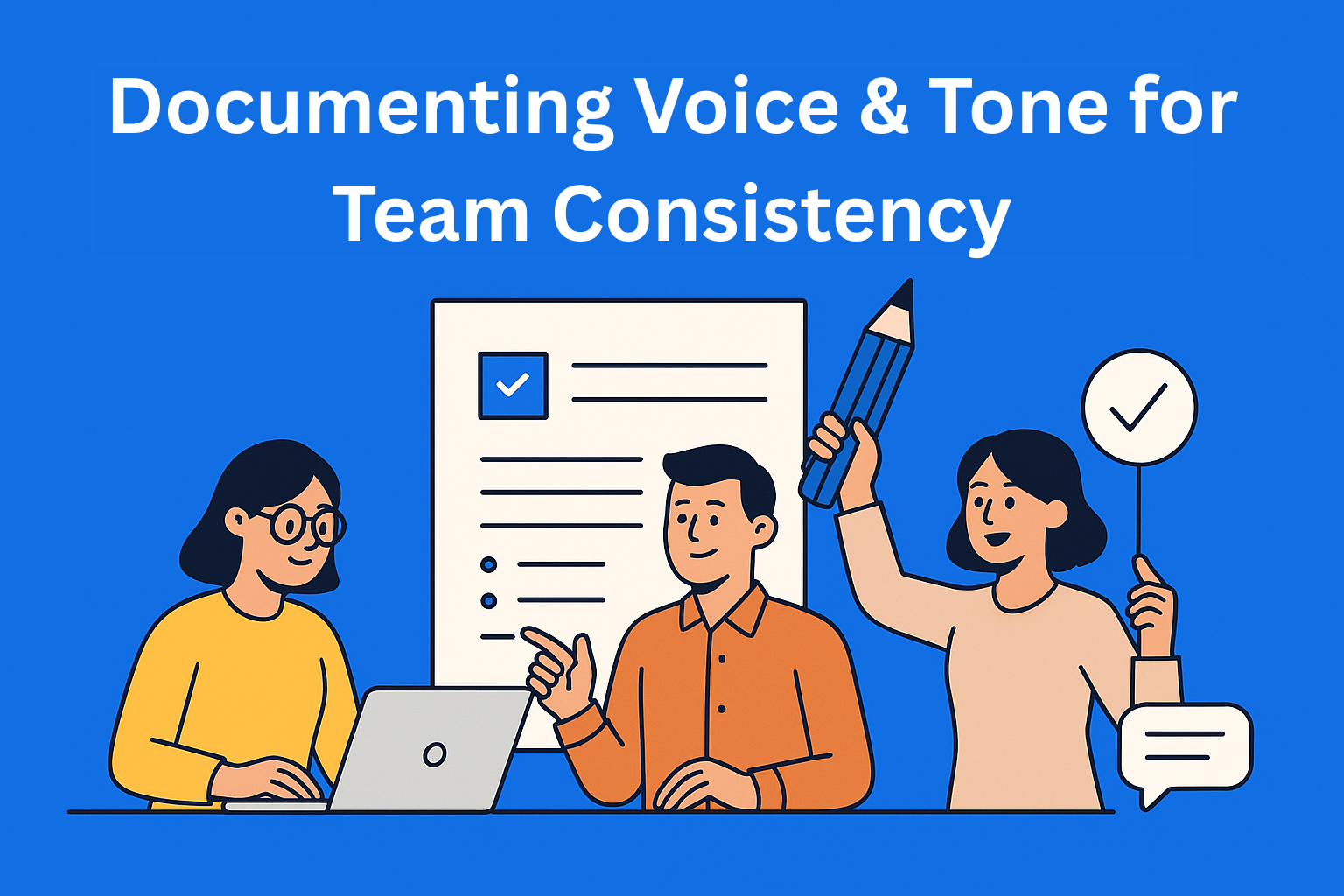How to Document Voice and Tone So Your Whole Team Sounds Aligned
Without documented voice and tone guidelines, your content quickly becomes inconsistent. This guide shows you how to create a voice & tone document your team will actually use, across the entire content workflow, with examples, tips, and workflow tricks.

Content teams don’t write in silos anymore.
Writers, editors, reviewers, freelancers, AI tools - there are more people (and platforms) involved in content creation than ever. And with all those moving parts, one thing can fall apart quickly: your brand’s voice and tone.
You might have beautifully written web copy, but then your blog posts sound like they were written by a different company. Your newsletters? Casual and witty. Your landing pages? Corporate and stiff. The result? A confused audience and a brand that feels inconsistent.
That’s why documenting your brand’s voice and tone guidelines isn’t just a “nice to have” anymore - it’s essential. Especially if you want your content to feel cohesive from draft to publish.
In this blog, we’ll walk through exactly how to document voice and tone in a way that actually works for your team - not just in theory, but across every step of your content workflow.
Key Takeaways
- Voice defines your brand personality - and tone adapts it to context. Without documentation, teams default to personal styles, causing inconsistency.
- Every guide should be actionable - Include core voice traits, tone-by-context rules, audience preferences, examples (good & bad), and quick formatting notes.
- Embed tone into the workflow - Writers, editors, and reviewers need tone guidelines "where they work" - inside briefs, templates, checklists, and review steps.
- Keep the guide practical and visible - Short, searchable, regularly updated, and easy to access during onboarding, reviews, and content planning.
- Consistency builds trust - When everything sounds aligned (emails, blogs, landing pages), your brand voice becomes stronger and more memorable.
Why Voice and Tone Documentation Matters More Than Ever
A brand’s voice is like its personality - it shouldn’t change depending on who’s writing. And tone? That’s the mood or attitude you use to deliver that voice, depending on the context.
For example, your voice might be “confident and helpful,” but your tone will shift depending on whether you’re explaining a product feature or responding to a customer complaint.
Without documentation, it’s all up for interpretation. Every writer brings their own spin. Editors make changes based on personal preferences. New team members try to reverse-engineer “what sounds right” by looking at old posts. And when AI gets thrown into the mix, that's where things get fun.
Proper documentation helps fix that. It brings consistency, clarity, and alignment to your entire team - especially when it’s baked into your content workflow, not just buried in a shared folder.
What Every Voice and Tone Guide Needs to Include
Let’s start with the basics: what should this document actually cover?
1. Your Brand Voice (Core Attributes)
This is your always-on writing personality. Choose 3-4 core traits that define how your brand “speaks.” For example:
- Confident, not cocky
- Friendly, not overly casual
- Direct, not blunt
Make sure to define each one and include “do/don’t” examples so it’s easy for writers to apply.
2. Tone Guidelines by Context
Here’s where you get situational. How does your tone shift when:
- Writing for new visitors vs. existing customers ?
- Sharing thought leadership vs. product updates ?
- Writing error messages vs. blog intros ?
A simple chart or section for each context works well here. It helps your team understand when it’s okay to be playful - and when it’s not.
3. Audience Awareness
Voice and tone aren’t just about you - they’re about your reader. Define your key audience segments and the tone that resonates best with each. If you have personas, this is a good place to tie them in.
4. Examples (Good and Bad)
Show, don’t just tell. Include examples of on-brand copy (headlines, intros, CTAs, product blurbs) and point out what makes them effective. Do the same for common mistakes or phrases to avoid.
5. Formatting and Style Rules
While not part of voice per se, things like sentence structure, emoji usage, contractions, headline capitalization, and Oxford comma preferences all impact how your content “feels.” Add them here or link to a broader style guide.
Documenting Voice and Tone Across the Workflow
Having one central document is important - but if your goal is consistent content, you also need to apply those guidelines at each stage of the workflow. Here’s how.
Writing Stage
Writers need a simplified, quick-reference version of your guidelines while they’re working - not just a 10-page PDF.
- Embed key voice/tone rules in your content briefs or templates
- Highlight the tone expected for the piece (e.g. “Professional but relaxed”)
- Include checklists for style and tone
- Add audience notes right next to the writing fields
If your team uses AI for first drafts or ideation, make sure your tone guidance is reflected in prompts. AI can only replicate what you tell it, and it won’t automatically match your voice unless you train it to.
Editing and Review
Editors aren’t just there to fix grammar - they’re the second line of defense for tone.
- Include tone checks in the editing process
- Ask editors to flag off-brand phrases or sentence structures
- Define what tone issues look like, so reviews aren’t based on gut feeling
Your editor should be able to justify a rewrite based on your tone documentation - not just personal taste.
Approval and Final Review
Before publishing, content should go through a final tone check.
- Does it match the tone for the channel?
- Are there inconsistencies between sections?
- Is the headline tone aligned with the rest of the piece?
This step often gets skipped in fast-paced teams - but it’s where final polish and brand consistency live.
How EasyContent Helps Keep Everyone Aligned
If your team is working across docs, spreadsheets, and email threads, keeping voice and tone consistent is an uphill battle. Guidelines get ignored, lost, or applied inconsistently - especially when multiple people are involved.
That’s where EasyContent helps.
Instead of keeping your tone document in a separate place, you can:
- Embed voice/tone guidance directly into templates, so writers always see them while drafting
- Create custom fields like “Tone Checklist” or “Target Audience Notes” that appear in every content brief
- Set up review steps for editors to specifically check for tone alignment
- Build custom workflows, so each person knows when it’s their turn and what they’re supposed to be looking for
It's always easier for people to stick to something if they don't have to look it up in several different tabs.
Tips to Make Your Voice and Tone Guide Actually Useful
A lot of tone documents get created, shared once, and then forgotten. To keep yours alive:
- Keep it short and practical - aim for clarity over completeness
- Make it searchable and skimmable - use headings and examples
- Update it regularly - your brand evolves, and so should your voice
- Build it into onboarding - new writers and editors should get a walkthrough
- Refer back to it often - during reviews, meetings, or campaign kickoffs
- Make it easily accessible - your team shouldn't waste too much time searching for the guide
The more your team sees it in action, the more naturally they’ll follow it.
Final Thoughts
A consistent voice and tone isn’t just about sounding polished - it’s about building trust.
When your blog, emails, product pages, and social posts all sound like they’re coming from the same team (and the same personality), your brand becomes more memorable and more believable.
That kind of alignment doesn’t happen by accident - it happens through documentation, systems, and reinforcement.
So if you’re tired of fixing tone at the last minute (or wondering why each piece of content sounds slightly off), it might be time to create (or refresh) your voice and tone guide.
And if you want to make sure it actually gets used, consider building it into your workflow - whether you use a tool like EasyContent or create your own repeatable system.
Your audience will hear the difference.






